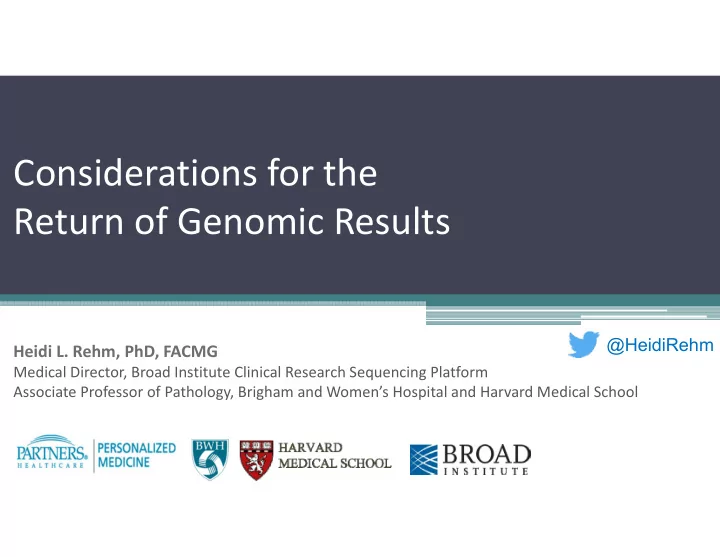

Considerations for the Return of Genomic Results @HeidiRehm Heidi L. Rehm, PhD, FACMG Medical Director, Broad Institute Clinical Research Sequencing Platform Associate Professor of Pathology, Brigham and Women’s Hospital and Harvard Medical School
Challenges to scaling genomic interpretation and ROR
Technical validity and sample identity ▫ Orthogonal confirmation with original sample addresses issues that happen even with CLIA NGS Analytical validity of results ▫ SNVs challenging in homologous regions ▫ InDels often challenging (e.g. PMS2, SMN1/2, VWF, STRC) Sample mix ‐ ups during testing process Courtesy: Diana Mandelker and Birgit Funke Consider making some data ▫ Yet, duplicate specimens and orthogonal available separately as unconfirmed research results confirmation are not scalable requiring CLIA confirmation
Quality Scores for NGS Data – When is Sanger required? Whole Genome Variants Assume TP 373 Assume True Positive 31 Require Sanger (7.4%) 13 Assume False Positive Require 417 Total Sanger Assume FP
MedSeq Variant Analysis Pipeline and Detection Rates <5% HGMD ClinVar * ~10 variants ~100 ‐ 200 ~5 million Technical Variant Gene for manual variants variants exclusions exclusions exclusions review Medical Novel <1% exome LOF ~5000 genes *In non ‐ diagnostic testing, 92% of variants Several hours of reported as pathogenic in HGMD had review per genome insufficient evidence to support the claim. Reported Average Review Novel null, Variant Type ~2% (0 ‐ 7) of filtered variants missense, Time 34% 39% reported in MedSeq Variant with literature 90 min Variant with no literature 26 min Pathogenic Reported null, 27% Likely Pathogenic VUS – Favor Pathogenic
Interpretation Differences in ClinVar 26% (97,422/377,075) of variants have ≥ 2 submitters in ClinVar 17% (16,631/97,422) are interpreted differently NEJM May 27 th , 2015 11% (12,895/118,169) of variants have 3.6% medically significant ≥ 2 submitters in ClinVar (P/LP vs VUS/LB/B) 1.7% medically significant 17% (2229/12,895) among clinical lab submissions are interpreted differently
Steven GeneDx Ambry Harrison LMM Chicago Pre ‐ Discrepancy Resolution Process 87% resolution (211/242) Post ‐ Discrepancy Resolution Process Harrison et al. Genet Med, in press
Variant Knowledge Evolution MedSeq Genome Reanalysis 22% (22/100) Participants Received New or Reclassified Variants Both, 3 Previously Unreported ~4% of cases Finding(s), 9 per year Reclassified received Finding(s), medium or 10 high alerts Expert Panel interpretations sometimes change as well Genet Med. Apr 2012 PMID: 22481129
Variant Reclassification Over 12 Years at the Laboratory for Molecular Medicine
Variant Reclassification Over 12 Years at the Laboratory for Molecular Medicine
Laboratory management of knowledge updates 1.Issue amended reports 2.Allow direct access to laboratory database (e.g. Emory) 3.Regularly deposit variants into ClinVar 4.Deliver automated knowledge updates on reported variants (e.g. GeneInsight)
Reports, Structured Variant Data and Variant Updates Returned Via EHR (GeneInsight Clinic)
Updated Variant Information
Prototype of a proposed EHR App Will bring in 3 ‐ 4 star variants from ClinVar
Proposal for AoU Genetic ROR • Begin with a small set of results that reach consensus for utility and sufficient evidence • Label “clinical” and expand scope once a successful process is achieved ▫ ACMG59 as starting point ▫ Pathogenic as starting point • Consider approaches to share additional data – label as “research” ▫ Enable participants to share their raw data broadly Array genotypes, BAMs, VCFs List of annotated novel, rare or suspicious variants ▫ Allow access to data when clinical context raises the prior probability of disease CLIA confirmations and interpretations can be ordered as needed ▫ Enable other studies that can delve deeper into the significance of these variants
Approaches to scale genomic interpretation • For novel predicted null variants, checklist can largely be automated if gene and exon level curation is performed in advance Are null variants an established mechanism of disease? How frequently are predicted null variants found in the gene in large population databases? Het vs hom? What is the constraint score in ExAC? Are there other known pathogenic variants in the exon? Also check ExAC for nulls in that exon. Is nonsense ‐ mediated decay predicted? Are there predicted null variants reported 3' (and 5’) to the variant? Is the exon alternatively spliced? • Rely on ClinVar review levels for reported variants ▫ Consider reporting only 3 star or 4 star variants ▫ Could add 2 star variants (all submitters agree)
Variant Curation Expert Panels (ClinGen ‐ approved and in planning) Hereditary Cardiovascular Inborn Errors of Neuro Hearing Loss Other Cancer Disease Metabolism developmental CFTR EP CFTR EP Cardiomyopathy Cardiomyopathy Hearing Loss EP PAH EP ENIGMA EP Rett/Angelman ‐ EP like Disorders PharmGKB PharmGKB FAO EP InSiGHT EP KCNQ1 EP RASopathies EP RASopathies EP Aminoacid ‐ CDH1 EP Brain FH EP opathy EP MODY EP Malformations PTEN EP EP Mito EP Somatic & TP53 EP Germline Cancer Curation Group Application approved by ClinGen for 3 star submissions to ClinVar Planning to apply to ClinGen for 3 star submission level 9318 expert reviewed variants in ClinVar (2.5%)
Which 1 ‐ 2 star variants to report? 250000 • Not all 2 star variants are created equal 200000 • Not all 1 star variants are created equal 150000 • 2 star: How many labs agree? Only 2 or many? 100000 50000 • Which groups(s) reported? ▫ Single submitter criteria provided (1 star) 0 0 star 1 star w/ 1 star 2 star 3/4 star ▫ Experienced clinical lab conflict single submitter subjective – opinion of physicians and clinical lab peers objective measures – volume of submissions in a disease area (data from ClinVar Miner) • Date of last evaluation (evaluated within last 1 ‐ 2 years)
Recommend
More recommend